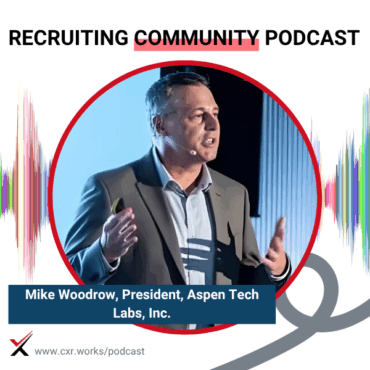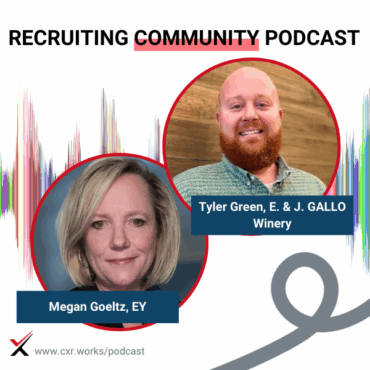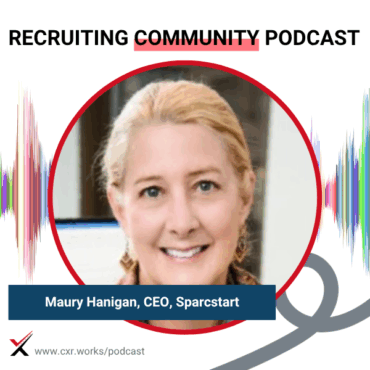
The Research Behind Employer Branding Videos
What happens when hiring managers send a 30-second video with job descriptions? This research-backed episode shows how it boosts engagement and cuts recruiter workload.
 play_arrow
play_arrow
Balancing Strategy and Tactics: Melissa Thompson’s Career Crossroads Cami Grace
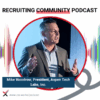 play_arrow
play_arrow
Real-Time Jobs Data and the TA Advantage Cami Grace
 play_arrow
play_arrow
20+ Years at Dell and Beyond: Jennifer Newbill’s Career Crossroads Cami Grace
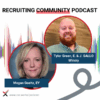 play_arrow
play_arrow
AI Interview Research Cami Grace
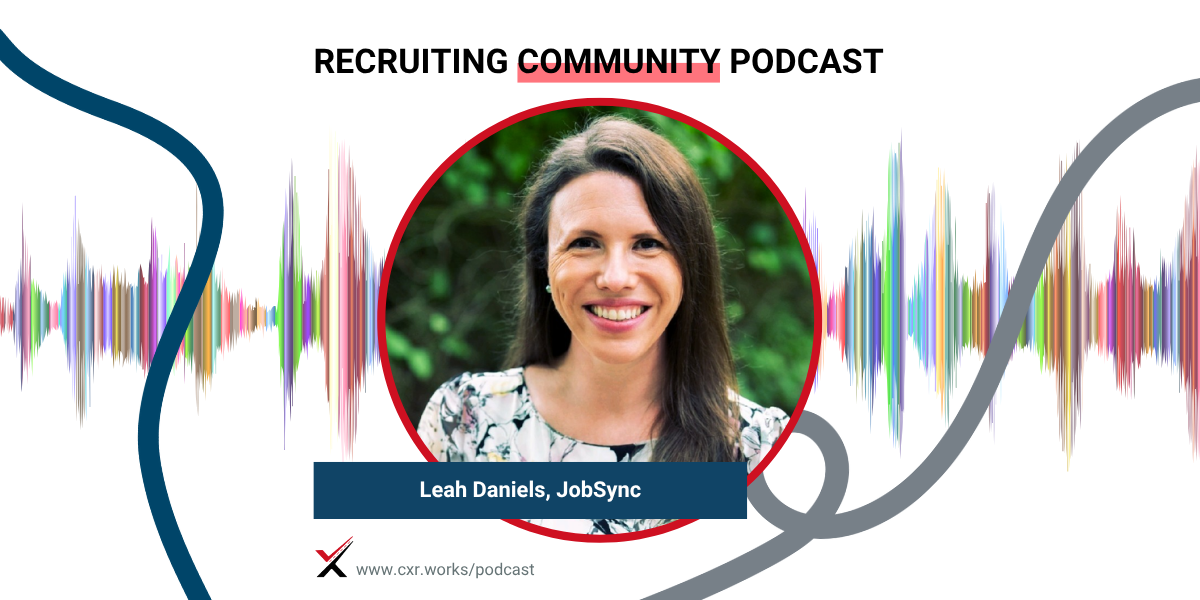
Summary:
In this engaging and slightly off-the-rails episode, we dive headfirst into the complexities and opportunities AI is creating for the talent acquisition landscape. From the rise of auto-apply tools and their impact on candidate volumes to the challenges of compliance, security, and data ethics, we cover it all. Joining us is Leah Daniels, Chief Commercial Officer at JobSync and recruiting tech veteran, as we explore the evolving arms race in AI-driven recruiting. Whether you’re curious about hyper-automation, the future of candidate experience, or how AI is reshaping recruiter roles, this episode is packed with insights and humor you won’t want to miss!
[2:33] Conveyor Belt Cheese & Sushi: A lighthearted start as we debate the merits of conveyor belt dining, from Amsterdam’s “Cheese Train” to post-pandemic food anxieties.
[6:15] Introducing Leah Daniels: Leah shares her background in recruiting technology, from ZoomInfo to JobSync, and her passion for solving sticky problems in recruitment marketing.
[13:40] The AI Arms Race in Recruiting: Candidates are applying to hundreds of jobs daily with the help of automation and AI, while recruiters scramble to manage the deluge. How can organizations keep up?
[18:22] Candidate Cheating or Innovation?: Exploring the ethical gray areas of AI-assisted applications and interviews. How should employers respond, and what’s the balance between transparency and regulation?
[25:12] Compliance and the Global Lens: Why staying compliant across regions, especially with the EU’s directives, is increasingly complex—and why legal partners are becoming recruitment’s new best friends.
[35:45] The Reality of Hyper-Automation: Will AI completely replace recruiters? Leah shares insights into how AI can complement human decision-making rather than replace it.
[44:02] Data, Security, and Cyber Challenges: The sensitive data collected during recruitment makes TA a prime target for cybersecurity threats. How can organizations protect themselves while optimizing processes?
[51:30] Leah’s Book Title: If Lee were to write a book about today’s recruiting trends, it would be called Help—a call for teamwork and support in navigating these challenging times.
If this episode got you thinking about the future of recruiting, we’d love to hear your thoughts! Don’t forget to rate, review, and share the podcast. Let’s keep the conversation going—because the future of talent acquisition is happening now.
Follow us at CXR on LinkedIn and check out all past episodes at cxr.works/podcast.
Title:
Trends to Watch for in 2025
Featured Guests:
Leah Daniels, Chief Commercial Officer, JobSync
Hosts:
Chris Hoyt, President, CareerXroads
Gerry Crispin, Principal and Co-founder, CareerXroads
Episode Overview:
In this episode, Leah Daniels joins the CXR team to unpack the rising impact of AI-powered auto-apply tools, the compliance challenges facing talent acquisition leaders, and what’s ahead for 2025. With candidates leveraging automation to apply en masse, employers are grappling with volume, sameness, and new regulatory responsibilities. The conversation explores how TA professionals must adapt their tools, processes, and mindsets to keep pace—and why transparency, legal alignment, and data discipline are more critical than ever.
Key Topics:
Surge in auto-apply tools like Loop and LazyApply
Impact of AI on resume rewriting and candidate sameness
Compliance and legal risks tied to AI use in hiring
Shifting recruiter roles and required upskilling
Increasing complexity of global and local data regulations
Transparency in candidate and employer AI usage
Inefficiencies in existing hiring processes and tech stacks
Trends in privacy, security, and data minimization
Notable Quotes:
“Candidates now have access to tools that can rewrite resumes, automate applications, and submit them at scale.” — Leah Daniels
“This is messy. It’s complicated. And we need solutions—fast.” — Leah Daniels
“Employers are scrambling. And some of the reaction is, ‘Hey, how do we stop them?'” — Gerry Crispin
“Instead of running from it, embrace it. See what the candidate can do with and without AI.” — Leah Daniels
“Let’s treat AI like a feature—not a product.” — Leah Daniels
“Your problem isn’t ‘you don’t have AI.’ Your problem is inefficiency, poor decisions, or bad processes.” — Leah Daniels
Takeaways:
As AI tools enable candidates to scale their job search, TA leaders must shift from reactive policies to proactive, compliant, and transparent hiring practices. The path forward involves embedding legal, operational, and technical expertise within TA, redefining recruiter capabilities, and treating AI as a means—not an end—to solving real problems.
Want more conversations like this?
Subscribe to the CXR podcast and explore how top talent leaders are shaping the future of recruiting. Learn more about the CareerXroads community at cxr.works.
Chris Hoyt: Looks like maybe what’s happening. All right. I think we’re on. I think we’re live. I think we’re something. It was there and it wasn’t. It counted. Jerry’s not sure either. That’s okay. I’m not sure.
So Leah, we were talking in the green room before this got started as it was streaming. The takeaway was, we’ll eat germ cheese over germ sushi.
Leah Daniels: Oh, 100% we eat germ cheese. I’m in. Chris and I were talking about a restaurant I went to last week in Amsterdam called The Cheese Train—loosely translated. It’s a sushi-style conveyor belt—but for cheese. How can you say no to this?
Chris Hoyt: I think it’s brilliant.
Leah Daniels: Jerry?
Chris Hoyt: I think it’s brilliant.
Leah Daniels: Jerry’s like, “No.”
Chris Hoyt: Jerry’s like, “No germs.”
Leah Daniels: No conveyor belt restaurants?
Gerry Crispin: No conveyor belt restaurants. I can’t handle it.
There was a restaurant when I was a kid that had a train track running around it. You got your hamburger on a choo-choo coming by your table. Maybe that was the early version of what you’re talking about.
Leah Daniels: Yes. Well, it’s evolved to more of a sushi restaurant style, at least here in the States. But the Dutch have a cheese version.
Chris Hoyt: I have to say—post-pandemic, I have a hard time with any food that people are permitted to hover over before I select it.
Leah Daniels: There’s a little cover. A little cheese cover.
Chris Hoyt: A little cloche?
Leah Daniels: Yes, a cheese cloche.
Chris Hoyt: Anyway… cheese.
All right, we’re going to jump in. Is everybody ready? We’re going to give it a shot. Here we go.
Announcer: Welcome to the CXR channel, our premier podcast for talent acquisition and talent management. Listen in as the CXR community discusses a wide range of topics focused on attracting, engaging, and retaining the best talent. We’re glad you’re here.
Chris Hoyt: Hopefully all the techno bugs work their way out, but I’m excited to welcome you back to the Recruiting Community Podcast. We do weekly insights and updates in the form of a conversation. If I’m kicking it off, I’m saying “spit spot,” everyone, and welcome!
No? Jerry’s not sure yet. Look, I’m here to tidy up the messy world of TA tech. And with me is the practiced Jerry Crispin. Some might call him the Mary Poppins of TA, if you will.
Gerry Crispin: God bless.
Chris Hoyt: That makes me Bert, I assume. But Jerry, did you bring a magic bag of tricks to help us with today’s topic?
Gerry Crispin: None whatsoever. It’s getting close to Christmas and I can’t think much more.
Chris Hoyt: Today we’ve got Leah Daniels from JobSync, and we’re going to dive into 2025 outlooks. Implications around auto-apply tools for job seekers—are they a problem? Do we care? Of course we care what OFCCP thinks. But how should it be handled and what does it mean for all of us?
There’s a balance employers and recruiters are still trying to figure out from a compliance standpoint and all this tech. So we’ll talk about that.
Quick reminder—we’re streaming on YouTube, Facebook, LinkedIn, Twitch. You can find all the past and upcoming episodes at cxr.works/podcast. If you’re watching on LinkedIn, drop a hello in the chat, introduce yourself, ask questions for our guest. If you’re catching this on replay, still comment—we’ll follow up.
Are we ready to welcome our guest? Yes? All right, here we go. Let’s put her in the big seat.
Leah Daniels: Hi! Good morning, good afternoon, good evening—good everything.
Chris Hoyt: Leah, you’re no stranger to this platform. You’ve got your own podcast, TalentSync. You’re the Chief Commercial Officer at JobSync. You’ve been at Appcast, Monster—you’ve seen some things. Want to give folks the escalator pitch on who you are and what you do?
Leah Daniels: Sure! As you mentioned, I’ve spent 20+ years in recruiting tech. Started at ZoomInfo when it was a recruiting tool. Did a stint at Bullhorn (ATS), ran strategic software at Monster, and worked on Clickcast at Appcast before joining JobSync.
I love sticky, icky problems in recruiting. JobSync tapped into the challenges between the ATS and all the candidate sources. How do we build bridges? Transparent solutions that solve real 10x problems. That’s why I’m here today—to talk 2025 trends.
Chris Hoyt: 2024 is almost a wrap, so we’re already talking about 2025.
Leah Daniels: Done. 2024 is over.
Chris Hoyt: Like old sushi in a bin on a conveyor belt—it’s done.
Leah Daniels: This analogy is never going to die.
Chris Hoyt: We’re going to ride it into the ground for the next 20 minutes. Let’s do it.
So we were talking about auto-apply tools. What’s really standing out to you tech-wise that we need to be paying attention to? Put a slant on it in terms of compliance, regulation, or just managing volume.
Leah Daniels: I love that the Wall Street Journal used the phrase “arms race” to describe AI in recruiting earlier this year. It’s accurate.
Candidates now have access to tools that can rewrite resumes, automate applications, and submit them at scale. Tools like Loop and LazyApply. So instead of 10 or 15 applications a day, it’s 200–500+.
On the recruiter side? Not the same level of AI or automation. Some high-volume employers have automation, but not at this scale, and not for professional roles.
Plus, companies have added complexity—global policies, legal governance, and risk. And then recruiters, especially junior ones, are downloading free AI tools that might raise compliance flags. There are legal and ethical concerns recruiters don’t even realize they’re stepping into.
So what’s the net out? This is messy. It’s complicated. And we need solutions—fast.
Gerry Crispin: Listening to you, it strikes me: candidates are ahead of employers for the first time. With the internet, it was the opposite. Employers were online while candidates were still mailing in resumes.
Now? Candidates are leading, and employers are scrambling. And some of the reaction is, “Hey, how do we stop them?”
Leah Daniels: Exactly. And on top of that, recruiting teams are being told to “do more with less.” Teams are shrinking, expectations are growing, and now there’s a need for hyper-automation—not just a little automation, but full-scale.
Chris Hoyt: I’m not seeing recruiters being cut, but I am seeing operational roles being reassigned or removed.
Scheduling is still the biggest win. That’s where tech has the most impact.
But let me be the contrarian. Let’s say I already do high volume recruiting. Suddenly, I’ve got 250 applicants instead of 25. So what? That’s a win, right?
Leah Daniels: Not necessarily. In professional roles, these mass-apply tools are causing issues.
Sure, 250 sounds great, but if the first 50 resumes all look the same—thanks to AI rewriting them—how do you distinguish anyone? That’s the problem. They all use the same buzzwords. It’s not just volume—it’s sameness.
Gerry Crispin: And then when you screen them, you get that awkward pause, then a perfect answer. Then the next one gives the same answer.
Chris Hoyt: You can’t say “pregnant pause,” Jerry. It’s “digestive pause” now. Or “burpy pause.”
Leah Daniels: He’s AI—Actual Intelligence. We’ve known it for years.
Chris Hoyt: So, what do employers do? How do they handle this?
Leah Daniels: It depends on each company’s tolerance, policies, and geography.
First: know what’s legal.
Second: transparency. Employers should clearly state how they use AI and ask candidates how they are using it.
Bake AI into the process. Instead of running from it, embrace it. See what the candidate can do with and without AI. That’s where critical thinking comes in.
Recruiters need new skills to interpret AI-enhanced interviews and outputs. We haven’t trained for that yet.
Gerry Crispin: Transparency on both sides. Let candidates know how AI is used. And we need to define what’s “cheating” versus using tools appropriately.
Chris Hoyt: But do we have a history of evolving efficiently? No. We respond, but we don’t anticipate well.
Some companies like CarMax and Samsara are changing how they interview. Is the path of least resistance to shift to assessments and away from traditional interviews?
Leah Daniels: That conflicts with the idea of candidate experience, right? Adding long assessments up front?
Also, let’s not forget—2024 is the peak of the U.S. employable population. We’re about to decline.
We’ll need to be more efficient in getting to the right people. That could mean more transparency—like telling candidates, “Hey, you’re applicant #470 this week.”
Chris Hoyt: I think candidate experience is declining. So is DE&I. It’s cyclical. We pay attention, then we drift. I think we’re going to throw half-measures at this and hope it works.
Gerry Crispin: I think that drives innovation. The mess forces us to find better ways. Maybe we use AI to collect better data upfront—fairly and at scale. That could lead to better decisions.
Leah Daniels: Agreed. And we still have two markets: desk workers and non-desk workers. The angst is coming from desk workers—but that’s a smaller group.
And AI could help recruiters—like AI agents doing first-round screens. But we need to be transparent upfront. “This is our process. It includes AI.”
Gerry Crispin: What does that mean for the recruiter role?
Leah Daniels: Some companies are going to try to go fully human-less. We’ve seen it—Amazon, UPS, Circle K. But the ghosting rate on Day One is still high.
There’s something irreplaceable about human connection—at least right now.
Chris Hoyt: But new tech isn’t cheap. And TA budgets aren’t increasing. So most orgs will try half-solutions or throw referrals at the problem.
We’ll see some great examples and a lot of “meh.”
Leah Daniels: And there’s a compliance angle, too. If AI evaluates answers, what data is it using? Companies need legal and ethical oversight embedded in TA.
We’re seeing more AI champions being hired in TA—not just in legal.
Also, we need more people who understand databases and data structures. If AI is pulling from demographic data, you need to know that.
Gerry Crispin: Upskilling TA teams to ask smart questions during RFPs.
Leah Daniels: Exactly. And it’s not just big vendors anymore. Anyone can spin up an AI tool now. So we need better vetting.
Chris Hoyt: For those listening, check out the AI vendor question list we co-created at cxr.works/ai-rfip.
Leah Daniels: Yep, great resource. Use it.
Chris Hoyt: So as we look beyond 2025—is there a trend you’re hopeful for?
Leah Daniels: I hope we stop calling everything “AI.” Let’s treat it like a feature—not a product.
Your problem isn’t “you don’t have AI.” Your problem is inefficiency, poor decisions, or bad processes. AI might help—but only if it’s the right solution.
Chris Hoyt: We’ve got to stop buying tech for the sake of tech.
Leah Daniels: Exactly. And another trend? Compliance management. Globally and locally. State laws. EU directives. It’s too much for one person.
We’ll see more legal and ops embedded in TA.
Chris Hoyt: And security. Candidate data is juicy and vulnerable. We collect so much info we don’t even need anymore.
Leah Daniels: Yes! Why do we ask for SSN up front? Or full addresses? Or references in the application?
That’s just risk. We need to trim what we collect—and secure it better.
Gerry Crispin: Maybe AI can help us manage our tech stack. Ask: “If we buy this, what can we eliminate?”
Chris Hoyt: Only if AI actually works. I spent 30 minutes with Gemini today trying to get a formula working in Google Sheets. ChatGPT fixed it in two.
Leah Daniels: Clippy would have helped. We need a new Clippy.
Chris Hoyt: All right, before we wrap—we ask every guest this: If you were going to write a book about the state of things, what would the title be?
Leah Daniels: One word: Help.
These challenges are all team sports. And no one person can do it alone. We need new roles, new skills, and support.
Chris Hoyt: Who gets the first signed copy?
Leah Daniels: My husband. Or I’ll be divorced. Then my mom. And a few mentors.
Chris Hoyt: We’re so glad you joined us today, Leah. Have a wonderful holiday and we’ll see you next year.
Leah Daniels: Thanks so much. Always a pleasure. Happy New Year!
Chris Hoyt: Mary Poppins, say goodbye to everyone.
Leah Daniels: Bye!
Announcer: Thanks for listening to the CXR channel. Please subscribe on your favorite podcast platform and leave us a review. Learn more at cxr.works. We’ll catch you next time.
Tagged as: Data Privacy, TA Transformation, JobSync, Podcast, AI Compliance.
Chris Hoyt is the President of CareerXroads, a global peer community for talent acquisition leaders driving strategic change. With decades of experience leading recruiting innovation at Fortune 500 companies, Chris now advises enterprise TA teams on tech, process, and leadership. He’s a frequent speaker at conferences like SHRM, HR Tech, LinkedIn, and UNLEASH, and he’s known for pushing conversations beyond buzzwords to get to what really works in hiring. Through CXR, he connects top TA professionals to solve real problems, challenge norms, and shape the future of recruiting.

What happens when hiring managers send a 30-second video with job descriptions? This research-backed episode shows how it boosts engagement and cuts recruiter workload.
